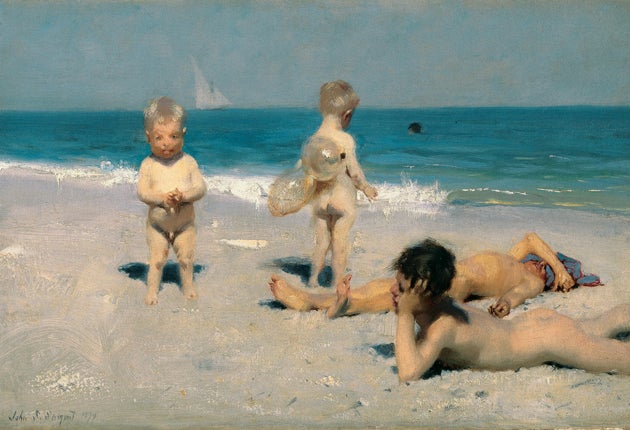Sargent and the Sea, Royal Academy, London
It's worth a quick visit to see convention-bound Sargent veer into the experimental with seaside pictures of children

It may be that, like me, you think of John Singer Sargent as an American society portraitist passing himself off as European.
And the only part of that view likely to be changed by the Royal Academy's new show of Sargent's work is that it reminds us that he painted seascapes as well as grandees, although these, too, end up by heading home for America after failing, quite, to be French.
What is the difference? Well, there's good and bad. I went along to Sargent and the Sea with a sure expectation of big skirts and parasols au bord de la mer, something along the lines of Eugène Boudin's Figures on the Beach at Trouville. Which, to be fair, was a case of mistaken identity on my part. Born in Florence but trained in Paris, Sargent missed the Impressionist boat by being a decade too young. If his brushwork occasionally has the scuddy looseness of Monet, a sometime friend, for the most part it doesn't. English critics may have found his style too Frenchified when he moved to London in 1886, but distance allows us to see Sargent's descent from the American realist, Thomas Eakins. And just as his brushwork is never really European, so neither is his take on marine painting.
The expansion of the railway from Paris to the Channel coast in the 1850s provided Sargent's French coevals with an exciting new subject – a world of resorts which was edgy in more senses than one, being between land and sea, between country and town. What became of Baudelaire's silk-hatted flâneur when you put him on a beach was a source of endless interest to Monet and Manet. To Sargent, though, brought up to the leisured, Henry James life of an American itinerant in Europe, the seaside meant something quite different.
In terms of its politics, his En route pour la pêche (1878) looks back beyond the Impressionists to Courbet. Where we might have expected – where I did expect – a nice line in hats and petticoats from Sargent's sea paintings, what we get are bare legs and wooden sabots. If his fisherwomen have cleaner fingernails than Courbet's farmhands, they none the less remind us that not everyone in 1870s Brittany had time to promenade. En route pour la pêche is about as far a cry from Sargent's silken portrait of Lady Agnew of Lochnaw, in the Scottish National Gallery, as it is possible to imagine.
Unexpected, too, is a picture such as Atlantic Sunset, painted from aboard an American-bound steamer in 1876. The most striking thing about this work, historically at least, is that it contains no land. Even Courbet's L'Immensité hadn't managed that, incorporating as it did a foreground smear of beach. Landless sea – sea on its own – was a brave subject for a man plagued, as a painter, by convention. It's tempting to see biographical detail in this: Sargent's descent from a long line of ship owners, say, or a particularly American (and non-European) feel for the sublime of wide open spaces.
Those of a more Freudian bent may see Sargent's taste for isolation in another way. The American was a lifelong bachelor. After his death, the French painter Jacques-Emile Blanche, an early portrait sitter, claimed that his American friend had been notorious in Paris as "a frenzied bugger". Whether or not this was so, Sargent's other main interest in the sea seems to have been its ability to get young men to take their clothes off. The Neapolitan subject of Nude Boy on Sands (1878) fixes the painter with a hie-thee-hither look oddly like that of his later society dames. The picture has the same stilted feel of the boys-and-boats paintings of Henry Scott Tuke, Sargent's exact English contemporary.
In a similar mood, although more interesting as images, are his pictures of small children. Where Sargent's adolescents and grown men tend to the cheesy, paintings such as Beach at Capri and Neapolitan Children Bathing have a structural weirdness that makes them look modern: if you were to see them in the Turner Prize show, you'd think there was some post-postmodern thing going on. The brushwork and palette of this handful of small pictures is also hugely experimental, as though Sargent, in painting innocence, was allowed to be innocent himself. They alone make the RA's exhibition worth a visit, although 20 minutes in the Sackler galleries should be plenty.
To 26 September (020-7300 8000)
Next Week:
Charles Darwent sees The Tightrope Walker at Timothy Taylor Gallery: a blurring of French art and design from the 1940s
Join our commenting forum
Join thought-provoking conversations, follow other Independent readers and see their replies
Comments